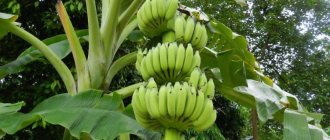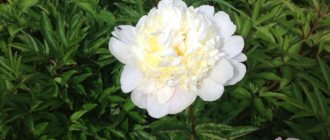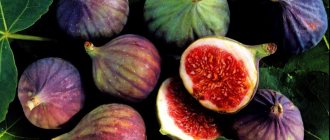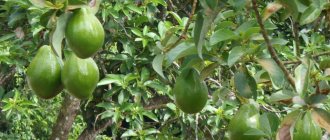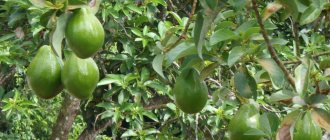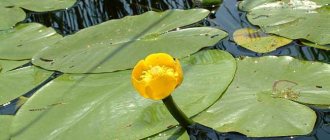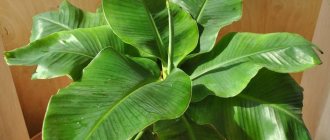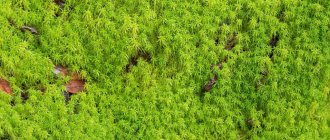How do they reproduce?
- using seeds;
- vegetative method.
Vegetative propagation is a faster and more reliable method than seed propagation.
Biologically, the process is as follows: after the plant bears fruit, its above-ground part dies off, and the root grows to the side, creating new bushes. Bananas are propagated by suckers and parts of the rhizome (rhizome). The most tenacious and productive offspring are formed during the fruiting of the mother plant; during this period they have the maximum supply of nutrients. As for planting rhizomes, it is best to use pieces weighing from 1.5 to 2 kg of whole rhizomes dug up from old plantations
Planting is best done at the beginning of the rainy season.
In nature, bananas reproduce using seeds located inside the fruit. At the same time, the wild banana fruit itself is inedible. It can contain from 50 to 100 seeds, sometimes their number reaches 200. Seeds germinate after falling into the ground (for example, when a ripe fruit falls). This takes time, because they are covered with a thick peel. After about 2 months, a green shoot will appear and the plant will begin to develop.
Due to vegetative propagation, cultivated banana varieties do not renew their gene pool, as a result of which they have little resistance to fungal diseases.
Soils with a high humus content and good drainage are best suited for plantation cultivation. If the drainage is poor, then the risk of infection by the same fungi increases many times over. To maintain high yields, it is advisable to use potassium and nitrogen fertilizers.
How does it bloom and bear fruit?
The plant is demanding on temperature conditions. The optimal daytime temperature ranges from +27-35C, and the night temperature should not fall below +25-28C. Even a short-term cold snap can provoke not only the falling of inflorescences, but also the death of the entire plant.
Similar negative consequences can be caused by a decrease in humidity levels. This may cause the banana to stop growing.
Optimal soils are fertile, slightly acidic
Particular attention is paid to weed control, for which they use special compounds, resort to mulching the soil and the help of geese. These poultry actively eat weeds, but are indifferent to bananas
Flowering of the grass occurs after 8-10 months of active growth. By this period, a peduncle emerges from the tuber, which is located underground, and passes through the entire trunk. By the flowering phase, it throws out a peduncle that is complex in structure, externally similar to a large bud. The color is purple, sometimes greenish.
Flowers form in the lower part of the “bud”. They are located in several tiers. At the top are the largest, female flowers, the second tier are smaller bisexual flowers, and at the very bottom are the male flowers, which are the smallest in size.
Despite the difference in size, all flowers have the same structure and include 3 tubular petals and sepals. In addition, there are erect and drooping inflorescences, which depends on the banana variety.
Pollination of female flowers occurs through insects, and this process does not stop even at night, since pollination is carried out by bats in the dark. There are no problems attracting insects, birds, and pollinating mice to banana inflorescences - their nectar is very sweet and aromatic. Over time, when the ovary is formed from the inflorescences, the “bud” begins to outwardly resemble a hand with many fingers.
As they ripen, the “fingers” turn into the well-known slightly elongated fruit with yellow skin. However, at first it is green, but turns yellow as it ripens. The size and appearance of the fruits vary and depend on the variety. During the ripening process, the pulp also changes - it acquires a creamy hue, softness, and juiciness.
From a botanical point of view, the fruits of the banana plant are berries. This is due to the fact that inside the pulp there are seeds arranged in a random or ordered manner. There are no seeds in cultivated fruits, while they are easy to detect in wild ones. However, if you cut the flesh of a cultivated banana lengthwise, you will find small dark spots - these are the seeds.
One inflorescence can produce up to 700 bananas, the total weight of which can reach 70-80 kg. After the fruiting period is completed and the plant is harvested, the false trunk dies off, in the place of which a new one will then appear.
On average, 16-19 months pass from planting to harvest. During the fruiting period, the trunk of the plant is strengthened with supports so that it does not break under the weight of the harvest. Harvesting begins when bananas are 75% ripe. They are cooled and transported. To preserve the freshness of the fruit, special conditions are required - a gas-air chamber with a temperature no higher than +14C. Under such conditions, bananas can retain their freshness and properties for up to 50 days.
Growing and caring for the plant
The banana tree reproduces by vegetative and seed methods. On plantations, the method of dividing the rhizome is used - this way the qualities of the variety are completely preserved. The root shoots are planted after the fruits are harvested. Due to the rapid growth and the presence of many dormant root buds, on an industrial scale, in the event of a hurricane threat, the bushes are pruned.
How to get seeds
To grow a plant, you will need its grains, which are preferably purchased at gardening stores or obtained from fruit purchased in a store. To do this you need to do the following:
- place the berries in a bag until the peel turns black;
- cut the pulp along the fruit to the core;
- extract the seeds;
- rinse well under running water through gauze;
- pour warm water and leave for several days, then rinse again.
But since the fruits are delivered to stores unripe, the seeds may not sprout. You should choose grains that are round in shape; flat ones will not sprout. The next stage is no different for planting both purchased seeds and those obtained independently. First, loosen the hard outer shell and rub it lightly with a nail file or sandpaper.
Germination requires a special substrate - sphagnum. But a mixture of sand and peat (3:1) is also suitable. A layer of drainage is placed at the bottom of the container, then soil 5-6 cm thick, and then each grain is placed in the substrate. The soil needs to be watered abundantly and a greenhouse made of polyethylene must be built. The temperature should be about 30 degrees during the day and at least 20 at night. The first shoots will appear in 2 or even 3 months.
Seedling care
A week after germination, each seedling is placed in a separate pot. Bananas will grow well on soil collected from under linden, hazel, and acacia trees. You need to add to it 2 parts of sand, 1 part of humus and 0.5 parts of ash. A good drainage layer is laid at the bottom. A young seedling penetrates its roots 2 cm into the soil.
Tillandsia - how it blooms, care at home
It is necessary to follow a certain regime for the healthy growth of a banana tree. Care at home consists of regularly loosening the top layer of soil, abundant watering, daily spraying and fertilizing. The plant must be placed in a warm, sunny place. It should also be noted that bananas tolerate dry soil better than excessive watering, which leads to rotting of the root system.
Banana diseases and pests
The tree at home is resistant to diseases. For prevention, it is enough to carry out root treatment with a weak manganese solution once every 6 months. When the foliage turns yellow and curls, it may become infected with a scale insect (appears on the bottom of the leaf as a brown spot). It must be removed manually. Another pest is the spider mite, which can be identified by light spots on the foliage and webs near the stem. In both cases, insecticide treatment is required.
Banana propagation (vegetative and seeds)
Bananas reproduce:
- seeds;
- vegetative method.
It is worth noting that the same plant grown using different methods will have different characteristics.
Growing bananas from seeds at home
Growing a homemade banana is quite easy. A banana grown from seeds is more viable, but the plant will take a long time to develop and produce inedible fruits. First, banana seeds need to be germinated. To do this, their surface is carefully treated with sandpaper or a nail file (a couple of scratches will be enough) so that the sprout can break through the hard shell. Be careful - there is no need to pierce the seed. Then the seeds are soaked in boiled water for several days until sprouts appear. The water must be changed every 6 hours.
The best container for planting bananas is a shallow pot with a diameter of about 10 centimeters. It is filled with drainage (a layer of expanded clay) 2 cm high and a 1:4 sand-peat mixture 4 cm high. To plant banana seeds, they need to be lightly pressed into the surface of the moistened soil, without covering them with soil. After this, cover the container with transparent film or glass and put it in a well-lit place away from direct sunlight. The temperature in the container should be between 27-30 degrees during the day and 25-27 degrees at night. As the substrate dries, it is moistened with a spray bottle. Some gardeners prefer not to remove the film from the container and moisten the substrate through the bottom of the container. If mold appears on the soil, it is necessary to remove it and water the substrate with a solution of potassium permanganate.
The first banana shoots appear after 2-3 months. From this moment, active growth of the plant begins, and after 10 days it can be transplanted into a larger pot. As the banana grows, it needs to be transplanted into a larger pot.
Vegetative propagation of bananas
A faster and more reliable way to obtain a plant with edible fruits is vegetative propagation. After fruiting ends, the false stem of the banana dies off, and new buds begin to develop from the underground stem to replace it. A new “trunk” grows from one. At this time, you can remove the rhizome from the container and carefully separate the piece with the awakened bud from it. This banana sprout needs to be transplanted into a prepared pot. As the plant grows, it needs to be transplanted into a larger container. It has been established that by the time of fruiting the volume of the pot should be at least 50 liters.
Diseases and pests
Like any plant, bananas can get sick and be damaged by pests. The most common of them:
- small beetles, larvae, which are called nematodes - they penetrate into the middle of the stems and begin to gnaw them;
- black weevils - crawl into the base of the stem, gnawing passages from which juice begins to flow in the form of jelly;
- due to the lack of renewal of the plant gene pool, cultivated varieties have low resistance to fungal diseases.
To combat pests, you can use special plant disinfectants. For prevention, you should not forget to moisten the soil. If the plantations are severely damaged, the infected plants must be destroyed.
How bananas grow on plantations
The banana plant has a structure characteristic of herbaceous species: powerful roots, a main stem on which there are huge leaves ranging from 6 to 20 pieces. After bamboo, the banana plant is the 2nd tallest plant in the world.
On plantations, bananas can grow with a stem thickness of up to 40 cm and a height of up to 8 m. Their leaves are 50 cm wide and reach 3 m in length, and they begin to grow not on branches, but from the depths of a hollow trunk, which is a characteristic feature of herbaceous plants. Having reached a certain height, the leaves begin to bend downwards from their own weight.
The powerful root system can be buried in the soil to a depth of up to 1.5 m and a width of up to 5 m in all directions. Each rhizome can live from 2 to 5 years, producing new shoots every six months. A characteristic feature of the structure of the leaves is a long longitudinal vein located in the center of the plate. The color depends on the plant variety and can be either green or with spots of burgundy or crimson.
The fruits grow in clusters, each containing up to 100 pieces. bananas Maximum productivity on plantations is achieved with high air humidity. In some areas, they even use a layer of polyethylene to wrap the ripening bunches to increase humidity and speed up the ripening of the fruit. However, this threatens the rapid emergence of fungal infections and diseases.
Origin of the word "banana"
There is no exact information about the origin of the Latin definition Musa. Some researchers believe that the banana was named in memory of the court physician Antonio Musa, who served in the service of Octavian Augustus, the Roman emperor who ruled in the last decades BC. e and the first years of our era. According to another theory, it comes from the Arabic word “موز”, which sounds like “muz” - the name of the edible fruits produced on this plant. The concept of “banana” passed into the Russian language as a free transliteration of the word “banana” from the dictionaries of almost all European languages. Apparently, this definition was borrowed by Spanish or Portuguese sailors at the end of the 16th and beginning of the 17th centuries from the vocabulary of tribes living in West Africa.
How to grow in open ground, where and under what conditions is this possible?
As already mentioned, banana grows mainly in the tropics. In Russia it grows south of Sochi, but does not bear fruit due to the harsh winter. There is a frost-resistant variety of banana palm, planting and caring for it in open ground does not require much expense. The name of this variety is Japanese banana.
Frost-resistant Japanese banana variety – Musa Basjoo
Watering is daily, excluding, of course, rain. Don’t forget about humidity, so on hot days you can also use sprinkling. To maintain soil moisture longer, mulching is also a good idea.
Important! This banana, of course, will not bear fruit, but will attract attention with its unusual “tropical” appearance. When the growing season is over and the leaves fall off, it is necessary to cover the stem for the winter and cover it with soil. In this form it can withstand frosts down to – 25 °C
In this form it can withstand frosts down to – 25 °C
When the growing season is over and the leaves fall off, it is necessary to cover the stem for the winter and cover it with soil. In this form, it can withstand frosts down to – 25 °C.
To grow a banana at home, you will have to try. But it’s worth it, because these plants will add a touch of originality and unusualness to the interior of any apartment.
Banana tree grown at home
An exotic plant can be recognized by the following characteristics:
- in tropical climates, banana trees reach 12 m in height, but at home they do not grow higher than 2 m;
- the length of the sheet reaches 2 m, and the width can be 1 m;
- the bases of the leaves fit tightly to each other, due to which a pseudostem is formed;
- the stem itself is underground, it also performs the functions of a root;
- inflorescences are formed in the middle of the ground stem and always die off after flowering.
Interesting! The banana tree is called a “tree” only because of its external resemblance. In fact, banana is a herbaceous perennial. Its terrestrial part lives no longer than 40 years.
There are several varieties of bananas that can be grown at home. Some of them, with proper care, are capable of bearing fruit:
- Pointed Banana;
- Cavendish is a dwarf;
- Cavendish is a super-dwarf;
- Kyiv dwarf;
- Kyiv superkalik.
Indoor pointed banana with fruits
In addition to fruit-bearing varieties, decorative indoor varieties are also grown:
- Velvety;
- Lavender;
- Chinese dwarf;
- Bright red.
Attention! To grow an ornamental variety, you can simply buy seeds. For fruit-bearing species, it is better to purchase ready-made seedlings
Chinese dwarf banana
banana stem
The banana stem is filled with fiber and also slows down the release of fats and sugars from the body's cells. Banana stem juice helps flush out toxins from the body and prevents excess fluid retention, making it one of the most effective ways to protect you from serious illnesses. One glass of banana stem juice with a few drops of lime juice every day will help prevent the formation of kidney stones, as well as relieve heartburn and abdominal discomfort.
The banana tree is a unique plant. Each part of it can be used to strengthen and maintain health. Eat one banana every day, make juice from the stems, consume flowers or leaves - your body will only say “thank you” to you. Within just a few weeks you will see amazing results and feel significantly better.
Found a violation? Report content
What kind of plant is this?
A banana is a herbaceous plant on which the fruits of the same name ripen. Even though the plant looks like a tree, it is a grass. Moreover, it is quite tall, the second tallest after bamboo.
Banana grass is called because of the absence of wood on the above-ground part of the plant. In fact, the trunk (it would be more correct to say “false trunk”) is formed by the leaves superimposed on each other. It is not surprising that in this case it does not have growth rings and branches. Over time, the banana leaves that form the trunk dry out, acquire a brown tint and, indeed, resemble a trunk more and more.
The herb belongs to the banana family, genus banana. It has branched rhizomes that spread over a distance of up to 5 m and can go 1-1.5 m deep into the soil. The banana is often called a tree because of its high false trunk, which reaches 2-12 m and has a diameter of up to 40 cm.
The banana also boasts impressively sized leaves - they reach 3 m in length and 1 m in width. These are “ovals” with a pronounced longitudinal vein and many thinner veins extending from it.
By the way, during a strong wind, the leaves tear along the veins, which reduces the pressure on them and eliminates the threat of the plant being torn out of the ground by a strong gust of wind.
Leaf color can vary significantly depending on the plant variety. There is grass with dark and light green leaves, sometimes with purple spots on top of the green color. There are varieties that are characterized by two-color leaves - they are crimson below and bright green above.
These huge leaves have a waxy coating on the outside, which prevents excessive evaporation of moisture from the leaves. As they age, the leaves fall off, and in their place new ones appear from the axils of the trunk. On average, it takes a week for a new leaf to develop.
The plant is often called a banana palm, due to some external similarity between the plants. However, such a classification is erroneous - the banana has nothing in common with palm trees.
The banana grows in areas with a tropical and subtropical climate. The world's largest suppliers of bananas are Pakistan, India, China, Thailand, Bangladesh, and Brazil. Under natural conditions, it is possible to grow the crop near Sochi, but winter temperatures here are still too low for it.
Today, about 70 varieties of bananas are known, all of them can be classified into one of three groups.
Decorative
These plants are cultivated not for their fruits (they are inedible), but for their attractive appearance, especially during the flowering period. In addition, the leaves and elements of the false trunk are used in industry - they are used to make car seats and fishing gear.
Among the most famous ornamental varieties are the following:
- “Pointed banana” has beautiful dark green leaves with serrations, thanks to which the leaf resembles a bird’s feather, bears fruit in warm climates, and the fruits can be eaten;
- The Blue Burmese Banana has an attractive silver-coated purple-green trunk, rich green leaves, and purple or blue-skinned fruit.
Plantano
Bananas of this variety grow large and are suitable for eating, but usually require heat treatment. Such fruits are fried, baked, deep-fried, dipped in batter. By the way, it is from these varieties of bananas that banana chips are made.
Since platano fruits are quite dense, they are subjected to heat treatment, but the ripe peel can be eaten fresh. To do this, you should choose sycamore with black peel.
Unlike dessert bananas, platanos have denser, unsweetened flesh and a dense skin. In addition to being eaten, they are grown as livestock feed.
In turn, bananas of the platano variety are divided into 4 groups - French, French carob, false carob and carob.
Dessert
Bananas are well known in our country and can most often be found on store shelves in fruit departments. They are consumed fresh, but the pulp of such bananas can also be dried and dried.
Among the most famous dessert varieties are “Paradise”, “Gros Michel”, “Ice Cream”. Miniature bananas are the “Lady Fingers” variety (fruit length is 10-12 cm).
Types and varieties of bananas, names and photographs
The genus includes about 70 species of bananas, which, depending on their use, are divided into 3 varieties:
- Decorative bananas (inedible);
- Plantains (platano);
- Dessert bananas.
Decorative bananas
This group includes plants with very beautiful flowers and mostly inedible fruits. They can be wild or grown for beauty. Inedible bananas are also used to make various textile products, car seat cushions and fishing nets. The most famous types of decorative bananas are:
- Pointed banana ( Musa acuminata)
grown for its beautiful leaves up to one meter long with a large central vein and many small ones, along which the leaf blade divides over time, acquiring a resemblance to a bird’s feather. The leaves of the ornamental banana are dark green; specimens with a reddish tint are often found. In greenhouse conditions, the height of a pointed banana plant can reach 3.5 meters, although in room conditions it grows no more than 2 meters. The size of the fruits of this type of banana ranges from 5 to 30 centimeters, and their color can be green, yellow and even red. The pointed banana is edible and grows in Southeast Asia, southern China, India and Australia. In countries with colder climates, this type of banana is grown as an ornamental plant.
- Blue Burmese banana ( Musa itinerans)
grows in height from 2.5 to 4 meters. The banana trunk is painted in an unusual violet-green color with a silver-white coating. The color of the leaf blades is bright green, and their length on average reaches 0.7 meters. The thick skin of banana fruits is blue or purple in color. The fruits of this banana are unsuitable for food. In addition to its decorative value, blue banana is used as one of the components of the diet of Asian elephants. Banana grows in the following countries: China, India, Vietnam, Thailand, Laos. This plant can also be grown in a pot.
- Velvet banana (velvety, purple, pink) ( Musa velutina)
has a false trunk height of no more than 1.5 meters with a diameter of about 7 centimeters. Banana leaves, colored light green, grow up to 1 meter long and 30 centimeters wide. Many specimens have a red edge along the edge of the leaf blade. The petals of the inflorescences, pleasing with their appearance for up to six months, are painted purple-pink. The pink banana peel is quite thick, and their number in a bunch does not exceed 9 pieces. The length of the fruit is 8 cm. When ripe, the skin of the fruit opens, revealing light pulp with seeds inside.
This variety of banana is used for decorative purposes. Can survive a not very cold winter. This banana is also unique in that it will bloom and bear fruit freely almost all year round at home.
- Banana vermilion (Indochinese banana) ( Musa coccinea)
is a representative of low-growing plants. Its height rarely exceeds one meter. The shiny surface of the narrow bright green banana leaves emphasizes the beauty of the juicy scarlet or red inflorescences. The flowering period of banana lasts about 2 months. Grown as an ornamental plant to produce beautiful orange-red flowers. The homeland of the Indochinese banana is Southeast Asia.
- Darjeeling banana ( Musa sikkimensis)
grows up to 5.5 meters in height with a false trunk diameter at the base of about 45 cm. The color of this decorative banana can have a red tint. The length of the gray-green leaves with purple veins often exceeds 1.5-2 meters. Some varieties of Darjeeling banana have red leaf blades. Banana fruits are medium-sized, up to 13 cm in length, with a slightly sweet taste. This species is quite frost-resistant and can withstand temperatures down to -20 degrees. Bananas are grown in many European countries.
- Japanese banana, Basho banana or Japanese textile banana (Musa basjoo)
cold-resistant species, reaching a height of 2.5 meters. The surface of the banana false trunk is colored in greenish or yellowish shades and covered with a thin wax-like layer, on which black spots are visible. The length of the leaf blades does not exceed 1.5 meters in length and 60 centimeters in width. The color of banana leaves varies from rich dark green at the base of the leaf to pale green at the tip. The Japanese banana grows in Japan, as well as in Russia on the Black Sea coast. It is inedible and is grown mainly for its fiber, which is used for the production of clothing, screens, and book bindings.
- Textile banana, abaca ( Musa textilis)
grown to make strong fibers from leaf sheaths. The height of the false trunk does not exceed 3.5 meters, and the diameter is 20 cm. Narrow green leaves rarely reach a length of more than one meter. The fruits, which develop on a drooping raceme, have a triangular appearance and sizes up to 8 centimeters. Inside the pulp there are a large number of small seeds. The color changes from green to straw-yellow as it ripens. Textile banana is grown in the Philippines, Indonesia, and Central American countries to produce durable fiber from which baskets, furniture and other utensils are woven.
- banana (fruit) (Musa balbisiana)
This is a large plant with a false stem height of up to 8 meters and a diameter at the base of more than 30 centimeters. Its color varies from green to yellow-green. The length of banana leaves can exceed 3 meters with a width of about 50-60 centimeters. The leaf sheaths are colored bluish and are often covered with fine hairs. The fruit sizes reach 10 centimeters in length and 4 cm in width. Banana skin color changes with age from light yellow to dark brown or black. Banana fruits are used as pig feed. Unripe fruits are canned. The male flower buds are eaten as a vegetable. The Balbis banana grows in India, Sri Lanka and the Malay Archipelago.
Platano (plantains)
Plantain (from the French plantain) or platano (from the Spanish plátano) are quite large bananas, which are mainly (90%) eaten after heat treatment: they are fried in oil, boiled, baked in batter, steamed or cooked of which are chips. The peel of the sycamore tree is also used for food. Although there are types of sycamore that, when fully ripe, become softer, sweeter and edible even without prior heat treatment. The skin color of sycamores can be green or yellow (although they are usually sold greenish); ripe sycamores have a black skin.
Plantains differ from dessert bananas in their thicker skin, as well as in tougher and almost unsweetened pulp with a high starch content. Platano varieties have found application both in the human menu and in agriculture, where they are used as livestock feed. In many countries of the Caribbean, Africa, India and South America, dishes prepared from platano are served as side dishes for meat and fish or as a completely independent dish. Usually they are generously flavored with salt, herbs and hot chili pepper.
Types of sycamore intended for heat treatment are divided into 4 groups, each of which has different varieties:
- French sycamores: varieties 'Obino l'Ewai' (Nigeria), 'Nendran' (India), 'Dominico' (Colombia).
- French carob-shaped sycamores: varieties 'Batard' (Cameroon), 'Mbang Okon' (Nigeria).
- False carob-shaped sycamores: varieties 'Agbagda' and 'Orishele' (Nigeria), 'Dominico-Harton' (Colombia).
- Horn-shaped plane trees: varieties 'Ishitim' (Nigeria), 'Pisang Tandok' (Malaysia).
Below is a description of several varieties of sycamore:
- Ground banana (banana da terra)
grows mainly in Brazil. The length of the fruit often reaches 25-27 cm, and the weight is 400-500 grams. The peel is ribbed, thick, and the flesh has an orange tint. In its raw form, platano is slightly astringent in taste, but after cooking it acquires excellent flavor characteristics. The leader among platanos in the content of vitamins A and C.
- Plantain Burro (Burro, Orinoco, Horse, Hog)
herbaceous plant of medium height, resistant to cold. Sycamore fruits are 13-15 cm long, enclosed in a triangular peel. The pulp is dense, with a lemon flavor, and is edible raw only when overripe, so the variety is usually fried or baked.
- Green banana
plant with large fruits up to 20 cm in length. The peel is greenish in color, slightly rough to the touch, thick. In its raw form it is inedible due to its strongly astringent taste, but is perfect for preparing all kinds of dishes: chips, vegetable stews, mashed potatoes. This type of plane tree grows in India, where it is in unprecedented demand among buyers in ordinary fruit shops.
Dessert bananas
Dessert varieties of bananas are eaten without heat treatment. In addition, they can be stored for future use by withering or drying. The most famous species of this group is the banana of paradise (Musa paradisiaca) . It grows up to 7-9 meters in height. The thick, fleshy banana leaves are 2 meters long and green in color with brown spots. The ripe fruit reaches a size of up to 20 cm with a diameter of about 4-5 cm. Up to 300 banana berries can ripen on one plant, the pulp of which contains practically no seeds.
Almost all species are artificially cultivated. Among them, the following dessert varieties of bananas are widely used:
- Banana variety Lady Finger or Lady Finger
with a rather thin false trunk reaching a height of 7-7.5 m. These are small bananas, the length of which does not exceed 12 cm. The skin of this banana variety is light yellow with thin red-brown streaks. One bunch of bananas usually contains up to 20 fruits with creamy flesh. Widely cultivated in Australia and also common in Latin America.
- Banana variety Gros Michel
up to 8-9 meters high and large fruits that have a thick yellow skin. The size of a banana fruit can reach 27 cm and weigh more than 200 grams. Banana pulp has a delicate creamy consistency. The Gros Michel banana variety tolerates transportation well. Grows in Central America and Central Africa.
- Banana variety Dwarf Cavendish
low (1.8-2.4 m) plant with wide leaves. The size of banana fruits varies from 15 to 25 cm. Their ripening is indicated by the bright yellow color of the peel with a small number of small brown spots. It grows in Western and Southern Africa, as well as the Canary Islands.
- Banana variety Ice Cream ( Ice Cream , Cenizo, Krie)
a rather tall plant with a false trunk height of up to 4.5 meters and elongated four- or five-sided fruits with dimensions up to 23 cm. The color of the peel of an unripe banana has a bluish-silver tint. As they mature, the color of the skin becomes pale yellow. Grown in Hawaii, the Philippines and Central America.
- Banana variety Red Spanish
is characterized by an unusual purple-red color not only of the false stem, leaf veins, but also of the peel of an unripe banana. As it ripens, the skin turns orange-yellow. The height of the plant can reach 8.5 meters with a trunk diameter at the base of about 45 cm. The size of the fruit is 12-17 cm. These red bananas grow in Spain.
Care
But it’s not enough to just sprout a banana. To prevent him from dying prematurely, he needs special care. Key Features:
Temperature
Bananas are native to the tropics, so the appropriate temperature should be observed. Cold is contraindicated for this resident of warm countries. In summer, the optimal temperature will be 26-30 °C, in winter - 18-21 °C.
Note! There are varieties that can survive the winter even when grown in open ground. It is enough to trim the plant so that about 10 cm remains on the surface and cover it with sawdust
But this is only suitable for regions with warm climates.
Spraying and watering
In an apartment it is difficult to achieve the conditions in which a guest from the tropics is accustomed to growing up. It is necessary to ensure humidity up to 65%, which is difficult to do, especially during the heating season. Therefore, it is recommended to spray the banana at least four times a day, in winter you can twice and wipe the leaves with a damp cloth.
Important! If possible, you can place a humidifier nearby. For homemade bananas, the soil needs to remain moist at all times.
It is recommended to water it 2-3 times a day in the summer; in winter, once a week will be enough. Additionally, you can remind the plant of its homeland with constant tropical downpours and water it in the shower
For homemade bananas, the soil needs to remain moist at all times. It is recommended to water it 2-3 times a day in the summer; in winter, once a week will be enough. Additionally, you can remind the plant of its homeland with constant tropical downpours and water it in the shower.
If you do not comply with these requirements, the leaves will begin to turn yellow, fall off, and it will be very difficult to revive the tree.
Lighting
The home banana loves bright sunlight. Ultraviolet radiation has a direct effect on its growth and development. Therefore, for proper care, it is better to place the plant on windows facing the sunny side of the house, but in particularly hot weather put it in the shade. If the tree is constantly in the shade, then it will stop growing, flowering, and you can no longer expect fruit from it.
Banana Lighting
Priming
It is best to choose a breathable growing medium with neutral acidity. A soil with these properties is available in most flower shops. If there are no such mixtures nearby, then you can make your own by mixing peat, sand, turf and leaf soil. Additionally, you can use additives to increase soil looseness.
Fertilizers
During the period of active banana growth at home, additional fertilizer is necessary. For this purpose, organic additives are used in diluted form. They should be applied once a week immediately after watering. After this procedure, the plant should be left in the shade for a day.
One of the interesting features of the banana tree is the absence of such a dormant period, which is typical for some plants. However, conventionally, this period is considered to be the winter season. With the onset of cold weather, the tree is given the opportunity to rest: kept at a temperature of about 20 ° C, watered and fertilized less often.
banana pruning
After the rest period, the flowering phase begins. But you shouldn’t expect a harvest in the first year. With proper care, banana fruits grown from seedlings will appear in two years, from seeds - in four.
If, first of all, you need not fruits, but a beautiful tree, then you can use the pruning method. As a rule, it is not recommended to do this at home, but if initially the banana does not please the eye with lush greenery, then pruning at the root will allow new shoots to appear.
Growing bananas at home
Many types of bananas can be cultivated in a greenhouse or even an apartment. Low-growing banana varieties with variegated decorative leaves and beautiful flowers are best suited for home cultivation. For the plant to feel comfortable, it needs a special substrate consisting of a mixture of universal soil, perlite and finely chopped pine, fir or spruce bark.
Watering a banana
Homemade banana is very demanding of moisture, but you should not over-water the plant. It is not recommended to place indoor bananas near central heating radiators or heating devices. To create the necessary humidity, the leaves and false trunk of the banana are sprayed with a spray bottle. For irrigation, settled water with a temperature of 25°C is used. Watering should be carried out without allowing the substrate to dry out by more than 3 centimeters. During the winter months, banana watering is limited.
Indoor banana fertilizer
To provide homemade banana with microelements, root and leaf feeding is carried out. It is advisable to alternate the use of mineral and organic fertilizers. In any case, you should not feed the plant more than once every 2 weeks. Root loosening of the soil, which provides free access of oxygen to the roots of the plant, has a good effect on the growth of bananas.
Fruit bananas (the fruits of which can be eaten)
Grown for its abundance of tasty fruits. Developed from two known species: Banana Balbis and Banana acuminate. Popular varieties are:
A low-growing variety with dense pale green leaves. The flower is bright red. Fruits abundantly.
Dwarf Cavendish banana (Musa acuminate Super Dwarf Cavendish)
Low fertile variety. The bright green leaf blades are wide and large. Burgundy flower.
It is still rarely found in apartments. Fans of indoor exotics like the plant with its powerful silhouette, large leaves and spectacular flowers. The giant plant looks good in a spacious room with high windows. Large space allows the plant to develop harmoniously and emphasizes its uniqueness.
In what countries do they grow?
Banana is one of the oldest plants cultivated by man. As Russian scientist Nikolai Ivanovich Vavilov established during his many years of research, its homeland is Southeast Asia and the Malay Archipelago. In this section we will look at where the banana grows and in which countries it is produced most.
In what countries do bananas grow? Nowadays, they are grown in at least 107 countries in Asia, Latin America and Africa with humid and tropical climates. It is used as:
- food product (fresh and dried);
- base for making banana beer and wine;
- raw materials for fiber production;
- ornamental plant.
Of course, the main purpose of banana fruits is to eat. The leader in the consumption of these fruits per capita is the small African country of Burundi - here each citizen eats almost 190 kg per year. It is followed by Samoa (85 kg), Comoros (almost 79 kg) and Ecuador (73.8 kg). It is clear that in these countries this crop is one of the staple foods. For comparison: on average, each Russian consumes just over 7 kg of bananas annually.
Banana crop ranks 4th in the world among cultivated plants, after rice, wheat and corn. This is not least due to its high calorie content - 91 kcal per 100 g of product, which is higher than, for example, potatoes (83 kcal per 100 g). The only drawback is how long it takes for a banana to grow. After all, before flowering begins, you need to wait 8 or more months until the plant itself ripens.
The export of bananas, which became possible with the advent of refrigeration units at the beginning of the 20th century, over time turned into a highly profitable business and remains so in our time.
The list of leaders in banana production for 2013 (in millions of tons) looks like this:
- India (24.9).
- China (10.9).
- Philippines (9.3).
- Ecuador (7).
- Brazil (6.9).
Banana products are imported mainly from European countries, the USA and Canada. The leader in this direction, the United States, purchases almost $2.5 billion worth of bananas every year.
Here you should immediately answer the common question “Do bananas grow in Africa?” As noted, they are native to tropical and humid countries, so yes. However, there are not as many of them here as in Asian and Latin American countries - the leader on the African continent is Tanzania, which produced 2.5 million tons in 2013.
Description, structure, characteristics
At first glance, the plant is associated with a tree, but in fact it grows like grass, having a powerful root system, a short, dense stem and up to two dozen large leaves. It ranks second in the world in height among herbs (the leader is bamboo, which grows up to 40 m). Unofficially, the plant is called “banana palm”. The fruit itself is officially recognized as a berry.
What group of plants does banana belong to: trees, shrubs, herbs?
Scientists argued about the species of banana for a long time, and only recently came to a common denominator. To do this, we had to combine and analyze a number of fruit growth facts:
- Banana belongs to the group of herbaceous plants.
- Grows as a perennial. The roots grow constantly in the ground and each season produce above-ground greenery called a false trunk (because, botanically speaking, it is not a trunk at all).
- Depending on the variety, the fruit can be considered a fodder crop or a fruit. Both are culinary use groups rather than botanical terms.
- The plant is a monocotyledon, that is, its seeds have only one cotyledon.
- The banana belongs to the angiosperm and flowering group because it grows flowers to spread its seeds and produces fruits from them.
- According to the type of fruit, it is classified as a berry.
Thus, scientists have come to the conclusion that the banana tree is a perennial monocotyledonous flowering herbaceous plant, which in terms of consumption is classified as fruit and feed. In the world, the crop grows in fourth place in terms of prevalence after rice, wheat and corn.
Trunk and roots
As expected, the culture grows starting from the root system. The rhizome is a true stem from which thinner roots grow that collect water and nutrients from the soil. The rhizome of a banana grows horizontally underground and forms nodes, by cutting which you can subsequently replant the plant (the answer to the question “how do bananas reproduce” is by division and shoots).
What grows above the ground and looks like a stem is actually a false stem. It has a fleshy structure filled with moisture. A pseudostem is formed from leaves tightly twisted together, which gradually unwind as they grow. When all the leaves have unraveled, the pseudostem stops growing.
Leaves
The organ grows primarily to carry out photosynthesis. Each leaf grows from the middle of a false stem, initially appearing as a twisted cylinder. The lower surface is rough, which is why it is called abrasive. The upper one is adaxial.
The very first leaves that emerge from the growing sucker are called hinged. Mature ones are simply called leaves and grow, forming a structure of blades, shells, middles and petioles. New banana leaves will fully grow within a week in favorable conditions, but the process can take up to three weeks in poor conditions. The fresh leaf is light in appearance and grows tightly curled; it feels fragile to the touch.
In the homeland of the banana, in Southeast Asia, the leaves are actively used as a wrapper for food.
How they bloom
The tree continues to grow for ten months, then begins to bloom. Banana flowering looks interesting: the stem of the banana inflorescence grows in length to the entire height of the pseudostem, and when it comes out, it forms a complex flower of green or purple color.
The flowers are located at the base of a complex inflorescence, and subsequently the fruit is formed from them. Flowers are arranged in tiers, and the order of arrangement is always strictly specific - male flowers grow at the bottom, bisexual flowers in the center, female flowers at the top. The flowers do not differ in structure; they all consist of three sepals and three tubular petals. Outside, the flower parts of the plant are covered with dark purple leaves, inside they are red, and the petals are usually white.
Birds and small mammals pollinate bananas. For example, bats flock to them at night.
Fetus
Small fruits grow on the trunk of the inflorescence in quantities of 200 to 300 pieces. A bunch of bananas sold in a store is a cluster of several connected fruits, but a branch of bananas in the wild consists of dozens of such clusters sitting on the trunk close to each other.
Initially, a banana in nature grows in a horizontal direction, but then gravity takes its toll, and the fruit branch begins to curl from top to bottom.
Interesting Facts
For residents of northern latitudes, not only what a “banana palm” looks like is educational, but also in what areas of their life a person can use this unique plant, how it is eaten, and many other facts are also interesting.
- In India, a very unusual use was found for the banana. When launching a ship into the water, the launching surface must be lubricated. For this, lard, paraffin, grease or other substance is used. Residents of India sometimes lubricate their slips with bananas. In order for a medium-sized ship to float, you need to take about 20 thousand fruits.
- Eating one banana is enough to provide a person with the daily requirement of potassium and magnesium.
- Black spots on banana peels are completely harmless. They say that the berry is ready for consumption and its further storage is undesirable.
- Not only the roots, but also the leaves of the plant help bananas to withstand strong winds. Under extreme conditions, leaf plates tear along the vein lines, thereby reducing the wind pressure on them.
The banana fruits that hit the shelves of Russian stores have undergone a long sea voyage. And it began in one of the 100 countries in the world where the crop is cultivated today.
What do bananas grow on? Ask the baby and you will hear in response that it is on a palm tree. But the children will say that. And those wise from life experience, scratching their heads, will say: “A banana grows on a banana tree, but it is not a tree at all, but a real grass, tropical and tall, like a tree.” And they are right, it is actually grass, although it looks like a tree.
Firstly, the banana does not have a trunk in the traditional sense, that is, it is a grass. And what looks like a trunk up to 6 m high (sometimes 9 - 10 m, why not a banana tree) are powerful leaves rolled into a tube. They begin to grow almost from the ground, and stretch upward together. And when 30-40 leaves grow, a peduncle appears inside the bundle, which also wants to go to the sun. And so he finds himself at a height of several meters.
Secondly, banana fruits are berries (according to the botanical classification), but berries, after selection, almost without seeds. There is one for every 250 bananas. Therefore, they are grown vegetatively. Even dried rhizomes do not lose their viability and grow after planting and watering. The settlers often used this and they knew well what bananas grew on. These fruits are used as dessert, in the form of flour, dried, pickled, fried, steamed, etc. After all, this is everyday food in Latin America, Africa, and Asia. Even the Germans eat up to 20 kg of bananas per person per year. And America is only 18 kg. But in Germany, from 1933, the Nazis began to need all the currency in the country, and since bananas did not grow there, they had to start anti-banana propaganda. “A small child died after eating bananas; a man who ate too many bananas was taken to hospital; “We are not monkeys, German strawberries are better than African bananas.” The film “Why is a Banana Yellow” was even banned, etc. But after the war, American bananas became a symbol of prosperity. And in 1995, Europeans introduced an international standard for “Eurobananas”. And the Americans who transported bananas to Europe do not fall under this standard - they are smaller in size. And although the Germans know what bananas grow on, competition is competition.
Thirdly, young banana plantations need to be weeded, and this is difficult to do under the scorching sun. Whereas in ancient Rome, geese were called to help because they ate weeds and did not touch bananas - they did not like them.
Kiev resident Anatoly Patiy also knows what bananas grow on in his garden. He has been growing them in a greenhouse for more than one year, and manages to get a “Kyiv Dwarf” harvest of up to 300, or even 400 fruits per plant, which is no less than 50 kg. The height of the “Kyiv Dwarf” grass is no more than 1.7 m, and the “Super Dwarf” is even lower - up to 1 m. They grow and bloom in a greenhouse at + 15–16 degrees Celsius. The size of one banana is up to 15 cm. A dwarf is a dwarf.
Bananas must be peeled before eating. Banana peels were used only in comedies, so that the hero would slip on it and fall in a very funny way. Now it is used in cosmetics, including for the removal of warts.
Banana peels, thoroughly dried, contain large amounts of tannin, a coloring agent for black leather products.
But the Brazilians went further. G. Castro (not to be confused with F. Castro, R. Castro and V. Castro) uses crushed peel to purify drinking water from copper and lead in 10 minutes and eleven times in a row. And Milena Boniolo from the state of Sao Paulo uses powder from the peel to clean industrial wastewater. And they don’t have enough of this goodness.
Interesting facts about bananas
- Among the world's agricultural crops, banana ranks fourth in popularity after wheat, rice and corn. The total number of bananas eaten per year by the world's population exceeds 100 billion.
- The islands of the Malay Archipelago are the birthplace of the banana. Residents of the archipelago have been growing this berry since ancient times and eating it along with fish.
- The first mention of the plant as an edible fruit appeared between the 17th and 11th centuries BC. e. in the Indian written source Rig Veda.
- In the collection Ramayana (Indian epic of the 14th century BC), one of the books describes the clothes of the royal family, which were woven from threads obtained from banana leaves.
- The Goldfinger banana variety, grown in Australia, has fruits that resemble apples in structure and taste.
- If you compare a banana and a potato, it turns out that the calorie content of a potato is one and a half times lower than that of a banana. And raw bananas are almost 5 times less caloric than dried ones. Among the products prepared from this fruit, banana juice is the lowest in calories.
Did you like the article? Share with your friends:
How does banana grass grow and bear fruit?
Despite all the efforts of breeders, it was possible to develop only a few varieties that can bear fruit at temperatures below 10 degrees. All other varieties, and there are more than two hundred of them, simply fall asleep at temperatures below 16-10 degrees, almost completely ceasing their vital functions.
The fruits of banana plants grow in one large cluster on a stem that grows between the leaves of a false trunk, rather than on the top itself, like coconuts. One such bunch can contain from several tens to several hundred fruits, depending on their size and type.
The opinion that a banana is a fruit is fundamentally incorrect, because only tree fruits are considered such. But berries are already growing on the bushes and grass. Therefore, bananas are typical berries, along with raspberries, currants or strawberries.
How bananas are harvested
In most cases, banana fruits are picked when they are not yet ripe in order to ripen them during transportation. The fruits do not always ripen completely, so in supermarkets you can find them still greenish, but at home they are already ripe.
Take the example of a banana plantation in Costa Rica:
- As soon as the bunches begin to fall off, they are immediately covered with a polyethylene shell to protect them from external damage that could lead to spoilage of the fruit before cutting. The ovaries develop in membranes for up to 11 weeks. This is not full banana ripeness, but sufficient for harvesting and transportation. The fruits are cut and hung on a special cable car, which delivers them to the packaging area.
- The job of collecting bananas is simple, requiring only two people. The first one cuts the bunches with a cleaver on a long stick, and the second one places them on his shoulders.
- The plant from which the fruit was collected is cut off so that it can no longer grow and bear fruit. A fresh sprout is immediately planted in the same place and grows until the next harvest.
- At the packing station, the bunches are placed in a tank of running water for 20 minutes until the juice stops leaking from the slices - otherwise their presentation will be ruined.
- At the packing station, fruits are subject to special inspection, and usually no more than 6% of the production is rejected. Waste" is not thrown away, but is used for baby food or baking banana bread.
- They are washed thoroughly. Women do this.
- After being removed from the water, the bunches are dried, wrapped in foil, placed in branded boxes and sent for sale. In most cases, they are delivered by sea, which is more convenient and cheaper.
You can get from Costa Rica to the USA in 10 days, and to Europe in 20 days. Therefore, more bananas are placed in “European” boxes, since the fruit shrinks slightly during travel. Depending on the exporting countries, be it Africa, Ecuador or the Canary Islands, delivery conditions and times may vary.
